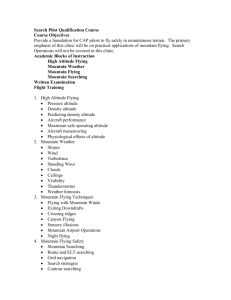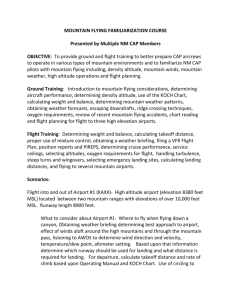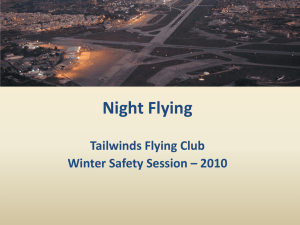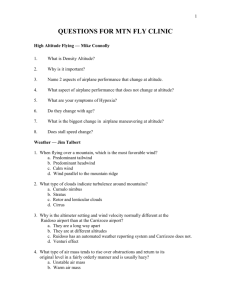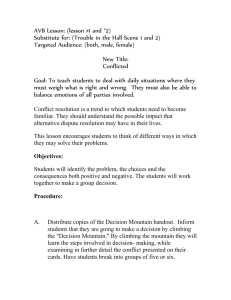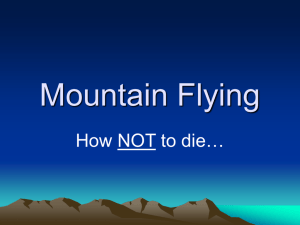Word - Aspen Flying Club
advertisement
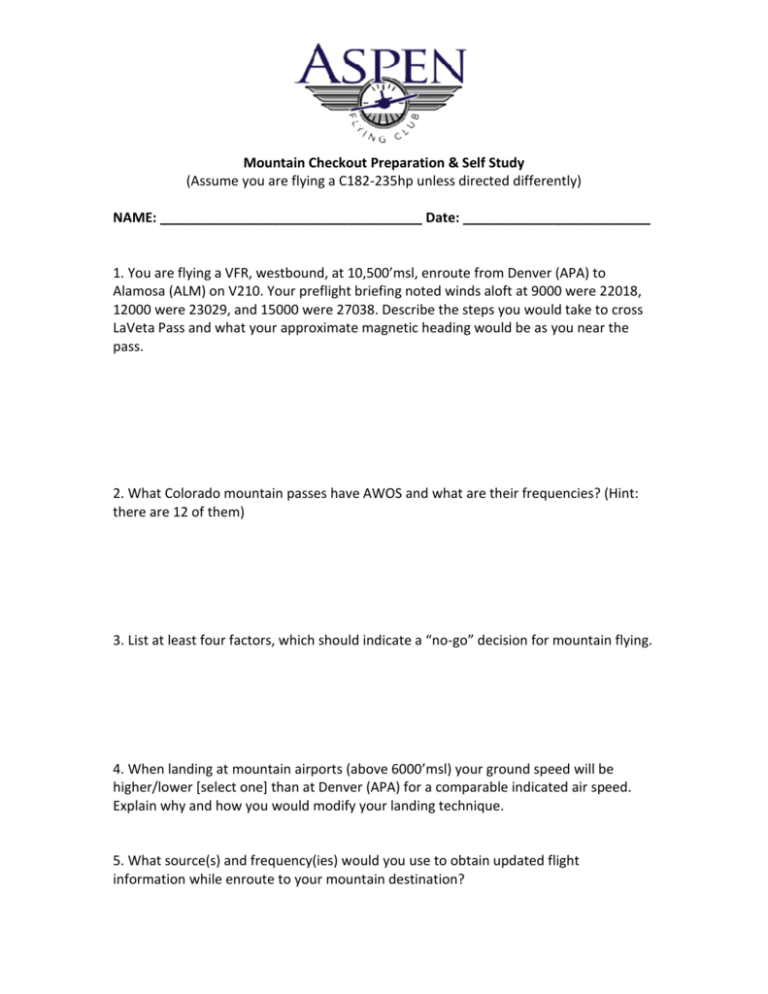
Mountain Checkout Preparation & Self Study (Assume you are flying a C182-235hp unless directed differently) NAME: ___________________________________ Date: _________________________ 1. You are flying a VFR, westbound, at 10,500’msl, enroute from Denver (APA) to Alamosa (ALM) on V210. Your preflight briefing noted winds aloft at 9000 were 22018, 12000 were 23029, and 15000 were 27038. Describe the steps you would take to cross LaVeta Pass and what your approximate magnetic heading would be as you near the pass. 2. What Colorado mountain passes have AWOS and what are their frequencies? (Hint: there are 12 of them) 3. List at least four factors, which should indicate a “no-go” decision for mountain flying. 4. When landing at mountain airports (above 6000’msl) your ground speed will be higher/lower [select one] than at Denver (APA) for a comparable indicated air speed. Explain why and how you would modify your landing technique. 5. What source(s) and frequency(ies) would you use to obtain updated flight information while enroute to your mountain destination? 6. It is a warm July afternoon and you are flying northbound in a mountain valley. Explain where in the valley you would fly and why? 7. Assuming that weather is not an adverse factor, describe the best route and altitude(s) for a VFR flight from Denver (APA) to Lake County (LXV). 8. You have entered what now is obviously a narrow, box canyon, the head of which is getting considerably larger in the windscreen, and which appears to be several thousand feet higher than your current altitude. How could this have been avoided and what will you do now that you’re in it? 9. What is the recommended minimum altitude (agl) to safely cross a mountain pass? What is YOUR personal minimum? 10. You are VFR and approaching the west entrance to Milner Pass enroute from Granby, CO to Fort Collins, CO. You have thirty minutes of daylight left when you experience a vacuum failure. Describe the action(s) you would take? 11. It is 1430 hours on a hot summer day and you are in the pattern for a landing at a mountain airport. You note the surrounding terrain is covered with high desert shrub but that there is a dense stand of Juniper at the approach end of the runway, just after a sharp ridge on short final. Describe the situation you expect on short final and how you would configure your aircraft for landing. 12. Name three factors related to mountain flying have a negative impact on engine performance and explain each. What else is affected besides the engine? 13. When mountain flying, what are the limitations, if any, regarding communication and navigation radio performance? 14. You are going from APA to Glenwood Springs via Leadville and Eagle CO. You call the Aspen, CO and Eagle, CO AWOS’s, and the surface winds are reported at 20 and 25 knots respectively. Is there a problem for this flight? If yes, what? 15. You are enroute from Denver (APA) to Missoula, MT (MSO) at 12,500’ msl with short excursions to 13,700’ msl for terrain clearance, and are about two hours into the flight. None of the periods above 12,500’ have exceeded twenty minutes. You note that you have developed a moderate headache which you attribute to the expired date store bought bargain pastry you had with the cup of coffee prior to your 0500 hours departure, but you are otherwise feeling pretty good. Is there anything wrong and, if yes, what, and what are the recommended corrective action(s). 16. Which performance charts are crucial for pre-flight preparations for landing at a high altitude, short mountain runway and why? 17. Enroute over mountainous terrain the airspeed indicator fails. What remaining instrument(s) will you rely upon to determine your airspeed? Would you continue the flight? 18. Describe the atmospheric conditions that create lenticular clouds and explain their effect on mountain flying. 19. What is the best time of day to fly in the mountains? Explain. Summer? Winter? 20. You’re going from Denver (APA) to Glenwood Springs via Eagle CO. Eagle’s AWOS reports a broken layer at 3000 feet. Can you complete this flight as planned? 21. You take off from APA and start your climb into the mountains. At 12,000 feet, your engine sounds rough. You apply carburetor heat and that makes it worse. What’s your diagnosis of the problem, can you fix it, and can the flight be safely continued? 22. On an early summer morning, three people leave Colorado Springs (COS) for Aspen, CO in a Cessna 172S (180 H.P.) with tanks topped (40 gallons). They use Independence Pass, which is high, long, and narrow, and which ends where the town of Aspen begins. They arrive at the airport at 8:30 a.m., have the tanks topped off, and take a bus to town for lunch. When they return to the airport it is 1400 hours and the temperature is 85 degrees F. They take off for the return flight to COS and decide to do their climbing on their way up the pass. They crash above timberline a short distance from the top. List any decisions and conditions which you feel could have contributed toward this bad ending. 23. What are the requirements concerning supplemental oxygen use under part 91? 24. You are preparing to depart Granby, CO in a C172SP for a cross country flight to Moab, Utah. The current altimeter setting is 29.45”. OAT is 85F. Two hours ago the altimeter setting was 29.65” and OAT was 71F. Two hours prior to that the altimeter setting was 29.99” and OAT was 63F. a. What is the current density altitude? b. Will you take off? 25. Based upon the previous question utilize the Koch chart to determine the likely rate of climb and additional take off distance required to clear a 50’ obstacle. Assume that you will weigh 2400 pounds.
